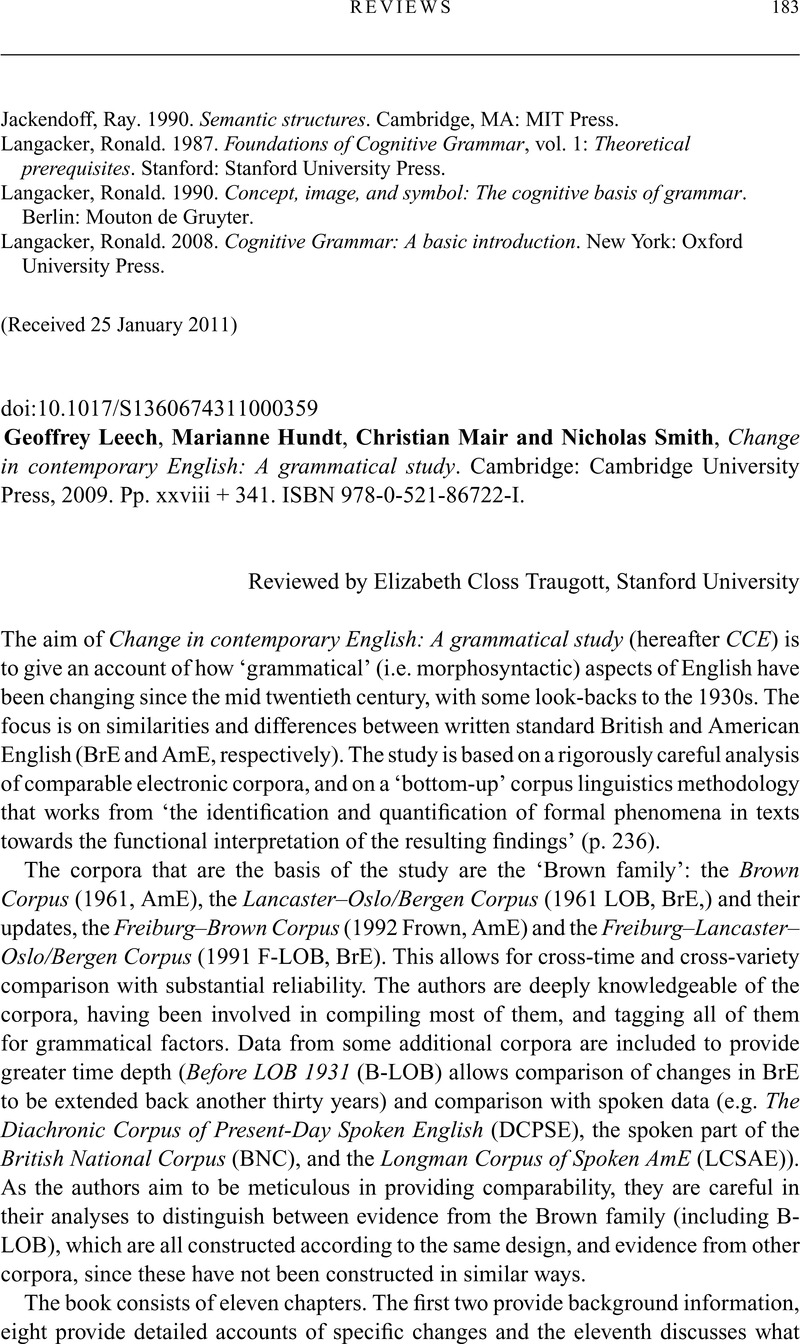No CrossRef data available.
Article contents
Geoffrey Leech, Marianne Hundt, Christian Mair and Nicholas Smith, Change in contemporary English: A grammatical study. Cambridge: Cambridge University Press, 2009. Pp. xxviii + 341. ISBN 978-0-521-86722-I.
Published online by Cambridge University Press: 17 February 2012
Abstract
An abstract is not available for this content so a preview has been provided. Please use the Get access link above for information on how to access this content.

- Type
- Reviews
- Information
- Copyright
- Copyright © Cambridge University Press 2012
References
Corpora (listed by acronym)
ARCHER. A Representative Corpus of Historical English Registers, compiled by Douglas Biber and Edward Finegan. www.llc.manchester.ac.uk/research/projects/archer/Google Scholar
B-LOB. Before-LOB, The Lancaster 1931 Corpus, compiled by Geoffrey Leech, Paul Rayson and Nicholas Smith. www.helsinki.fi/varieng/CoRD/corpora/BLOB-1931/index.htmlGoogle Scholar
BNC. The British National Corpus, subcorpus of speech. Distributed by Oxford University Computing Services on behalf of the BNC Consortium. www.natcorp.ox.ac.ukGoogle Scholar
Brown. A Standard Corpus of Present-Day Edited American English, for Use with Digital Computers, compiled by W. N. Francis and H. Kučera. Brown University. Providence, Rhode Island. icame.uib.no/newcd.htmGoogle Scholar
COHA. The Corpus of Historical American English (1810–2009), compiled by Mark Davies, Brigham Young University. corpus.byu.edu/coha/Google Scholar
DCPSE. The Diachronic Corpus of Present-Day English, compiled by Bas Aarts and Sean Wallis, Survey of English Usage, University College London. www.ucl.ac.uk/english-usage/projects/dcpse/Google Scholar
Frown. The Freiburg–Brown Corpus of American English, compiled under the direction of Christian Mair by Marianne Hundt, Andrea Sand and Paul Skandera. icame.uib.no/newcd.htmGoogle Scholar
F-LOB. The Freiburg–LOB Corpus of British English, compiled under the direction of Christian Mair by Marianne Hundt, Andrea Sand and Rainer Siemund, Englisches Seminar, Albert-Ludwigs-Universität Freiburg. icame.uib.no/newcd.htmGoogle Scholar
LCSAE. Longman Corpus of Spoken American English. www.pearsonlongman.com/dictionaries/corpus/spoken-american.htmlGoogle Scholar
LOB. The Lancaster–Oslo/Bergen Corpus, compiled under the direction of Geoffrey Leech and Stig Johansson by Eric Atwell and Roger Garside. Bergen: Norwegian Computing Centre for the Humanities. icame.uib.no/newcd.htmGoogle Scholar
References
Aitchison, Jean. 1991. Language change: Progress or decay? Cambridge: Cambridge University Press.Google Scholar
Biber, Douglas. 2003. Compressed noun phrase structures in newspaper discourse: The competing demands of popularization vs. economy. In Aitcheson, Jean & Lewis, Diana M. (eds.), New media language, 169–81. London: Routledge.Google Scholar
Bybee, Joan. 2003. Mechanisms of change in grammaticization: The role of frequency. In Joseph, Brian D. & Janda, Richard D. (eds.), The handbook of historical linguistics, 602–23. Oxford: Blackwell.CrossRefGoogle Scholar
Bybee, Joan. 2006. From usage to grammar: The mind's response to repetition. Language 82, 711–33.CrossRefGoogle Scholar
Davies, Mark. Forthcoming. Some methodological issues related to corpus-based investigations of recent syntactic changes in English. In Nevalainen, Terttu & Traugott, Elizabeth Closs (eds.), Handbook of the history of English. Oxford: Oxford University Press.Google Scholar
Fanego, Teresa. 1996. The development of gerunds as objects of subject-control verbs in English (1400–1760). Diachronica 13, 29–62.CrossRefGoogle Scholar
Hawkins, John A. 2004. Efficiency and complexity in grammars. Oxford: Oxford University Press.CrossRefGoogle Scholar
Hilpert, Martin. 2008. Germanic future constructions: A usage-based approach to language change. Amsterdam: John Benjamins.CrossRefGoogle Scholar
Himmelmann, Nikolaus P. 2004. Lexicalization and grammaticization: Opposite or orthogonal? In Bisang, Walter, Himmelmann, Nikolaus P. & Wiemer, Björn (eds.), What makes grammaticalization: A look from its fringes and its components, 19–40. Berlin: Mouton de Gruyter.Google Scholar
Krug, Manfred G. 2000. Emerging English modals: A corpus-based study of grammaticalization. Berlin: Mouton de Gruyter.Google Scholar
Hundt, Marianne. 1998. New Zealand English grammar, fact or fiction: A corpus-based study of morphosyntactic variation. Amsterdam: John Benjamins.Google Scholar
Lehmann, Christian. 1985. Grammaticalization: Synchronic variation and diachronic change. Lingua e Stile 20, 303–18.Google Scholar
Lehmann, Christian. 1995. Thoughts on grammaticalization. Munich: LINCOM EUROPA (2nd, rev. edition of Thoughts on grammaticalization: A programmatic sketch, 1982).Google Scholar
Los, Bettelou. 2005. The rise of the to infinitive. Oxford: Oxford University Press.CrossRefGoogle Scholar
Mair, Christian. 1997. The spread of the going to future in written English: A corpus-based investigation into language change in progress. In Hickey, Raymond & Puppel, Stanislaw (eds.), Language history and linguistic modelling: A festschrift for Jacek Fisiak, 1537–43. Berlin: Mouton de Gruyter.Google Scholar
Mair, Christian. 2006. Twentieth-century English: History, variation and standardization. Cambridge: Cambridge University Press.Google Scholar
Rohdenburg, Günter. 2006. The role of functional constraints in the evolution of the English complementation system. In Dalton-Puffer, Christiane, Kastovsky, Dieter, Ritt, Nikolaus & Schendl, Herbert (eds.), Syntax, style and grammatical norms: English from 1500–2000, 143–66. Bern: Peter Lang.Google Scholar
Rosenbach, Anette. 2010. How synchronic gradience makes sense in the light of language change (and vice versa). In Traugott & Trousdale (eds.), 149–79.Google Scholar
Rudanko, Juhani. 2006. Watching English grammar change: A case study on complement selection in British and American English. English Language and Linguistics 10, 31–48.CrossRefGoogle Scholar
Sapir, Edward. 1921. Language: An introduction to the study of speech. London: Harvest Books (original publisher Harcourt, Brace and World Inc.).Google Scholar
Smitterberg, Erik. 2005. The progressive in 19th-century English: A process of integration. Amsterdam: Rodopi.CrossRefGoogle Scholar
Taeymans, Martine. 2004. An investigation into the marginal modals dare and need in British present-day English. In Fischer, Olga, Norde, Muriel & Perridon, Harry (eds.), Up and down the cline: The nature of grammaticalization, 97–114. Amsterdam: John Benjamins.Google Scholar
Traugott, Elizabeth Closs & Trousdale, Graeme (eds.), 2010. Gradience, gradualness, and grammaticalization. Amsterdam: John Benjamins.CrossRefGoogle Scholar


